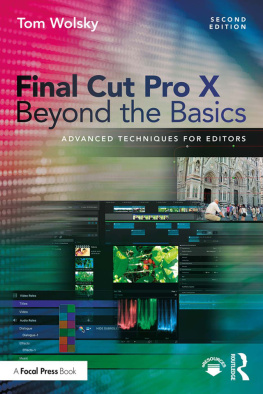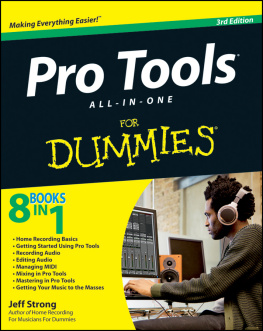Digital Audio Editing
Digital Audio Editing
Correcting and Enhancing Audio in Pro Tools, Logic Pro, Cubase, and Studio One
Simon Langford

First published in 2014
by Focal Press,
70 Blanchard Rd Suite 402
Burlington, MA 01803
Simultaneously published in the UK
by Focal Press,
2 Park Square, Milton Park, Abingdon, Oxon OX14 4RN.
Focal Press is an imprint of the Taylor & Francis Group, an informa business.
2014 Taylor & Francis
The right of Simon Langford to be identified as author of this work has been asserted by him in accordance with sections 77 and 78 of the Copyright, Designs and Patents Act 1988.
All rights reserved. No part of this book may be reprinted or reproduced or utilized in any form or by any electronic, mechanical, or other means, now known or hereafter invented, including photocopying and recording, or in any information storage or retrieval system, without permission in writing from the publishers.
Notices
Knowledge and best practice in this field are constantly changing. As new research and experience broaden our understanding, changes in research methods, professional practices, or medical treatment may become necessary.
Practitioners and researchers must always rely on their own experience and knowledge in evaluating and using any information, methods, compounds, or experiments described herein. In using such information or methods, they should be mindful of their own safety and the safety of others, including parties for whom they have a professional responsibility.
Product or corporate names may be trademarks or registered trademarks and are used only for identification and explanation without intent to infringe.
Library of Congress Cataloging in Publication Data
Langford, Simon.
Digital audio editing : correcting and enhancing audio in Pro Tools, Logic Pro, Cubase, and Studio One / Simon Langford.
pages cm
ISBN 978-0-415-82958-8 (paper back)
1. Digital audio editors. 2. Pro Tools 3. Logic (Computer file) 4. Cubase 5. Studio One (Computer file) I. Title.
ML74.3.L36 2014
780.28565dc23
2013023380
ISBN: 978-0-415-82958-8 (pbk)
ISBN: 978-0-203-51289-0 (ebk)

The irony is not lost on me that this book about editing of one form actually started out life roughly 50% longer than it ended up! It was very much an exercise in restraint and refinement that led from that initial form to the final product here. I have to thank everyone in my life for their patience and understanding while I have been deeply ensconced in the process of refining things down to where they finished up. However, special thanks must (of course) go to those who played a bigger part in the whole process.
I would first like to thank Meagan and Anais and all the other members of the Focal Press team who have worked with me in getting the ideas out of my head and onto paper. Writing any book is a labor of love, and the author will naturally have a vested interest. But the dedication of those whose sole aim is to bring knowledge to the world and empower others through that knowledge amazes me. To all of you, whether I have dealt with you personally or not, I give my deepest gratitude.
Then I need to thank my long-time collaborator, proofreader, and friend Alex Sowyrda. You, Alex, probably know nearly as much as I do about audio editing after reading through my original and painfully long version of this book, so I owe you my thanks once again.
I also need to thank the many, many people who have, over the years that I have been involved in the music industry, shared their expansive knowledge with me. I wasnt born knowing any of the information that I have included in this book, and it is only through the kindness and generosity of others and their willingness to share their own knowledge that any of this was possible. You all know who you are and what you have taught me, so this book is as much about your vast experience as it is about mine.
I also need to give my thanks to Rodney Orpheus at PreSonus, Emma Clifton at Avid, and the teams at Yamaha/Steinberg and Apple for their assistance in making this book happen.
And finally, given that this entire book is dedicated to the concept of making the best version possible of something, I have to give my personal thanks to the two people who drive and motivate me to be the best possible version of myself. I dedicate this book to Ben and Hayley, without whom I wouldnt have had the courage or belief to even get started on this long journey. My life simply wouldnt be as bright, as colorful, or as memorable without either of you, and I certainly wouldnt be the person I have become today.
Welcome to Digital Audio Editing: Correcting and Enhancing Audio in Pro Tools, Logic Pro, Cubase, and Studio One. During the course of this book, I will guide you through the principles and practice of a number of regularly used audio editing techniques, as well as a few less-frequent ones, and will wrap things up with a look at some of the more advanced and unusual editing techniques.
I would also like to point out, right at the very beginning, that the audio editing process can often cross over into the production process and even the sound design process. Many of the techniques that we will be looking at in this book could be seen as the fundamentals of sound design as well, and it is very tempting to branch off into both of these areas as an extension of what we will be looking at. However, in an effort to try to keep things focused and manageable, we should probably stick to the definition that audio editing involves taking sounds and recordings that we already have and making the best version of them for the purpose they have to fulfill. I would view sound design more as the process of creating new sounds, either from scratch or by heavily manipulating existing sounds or recordings, and would view production more as the process of combining the edited audio recordings into a finished piece.
The simplest analogy that comes to mind is that of building a house. We could consider audio editing as actually making the bricks as straight and uniform and correct as we can. These bricks are arranged and put in place by the builder (mix engineer) under the direction of the architect (producer) who has the blueprints for the building. If the bricks arent straight and uniform, then the builders job becomes far more difficult.
So with that in mind, lets ask the key question: What exactly is audio editing? I think that everybody would think of the obvious things such as cutting, pasting, cross-fades, and track comping, but there are many more ways to edit audio. As a general rule, we can put all these editing methods under one of three main headings: corrective, creative, and restorative. We will look at each of these in more detail as the book progresses, but, as a taster, I would suggest that the most common corrective tasks include the previously mentioned cutting, copying, pasting, and comping, while the most common creative tasks would include time-stretching and pitch manipulation. Restorative tasks are an area where technology seems to be changing at a ridiculous pace, and we now have the ability to do things that were simply unimaginable until fairly recently. We can carry out spectral repairs and manipulate individual sounds within a complex mix and further manipulate mixed recordings in some truly mind-bending ways. In fact, we can change pretty much any aspect of audio recordings in one form or another, some more successfully and easily than others, obviously.
Next page













